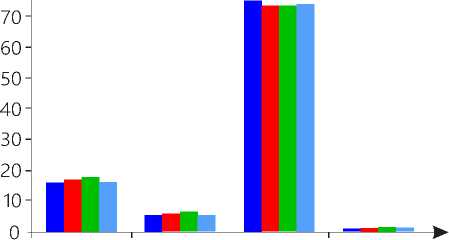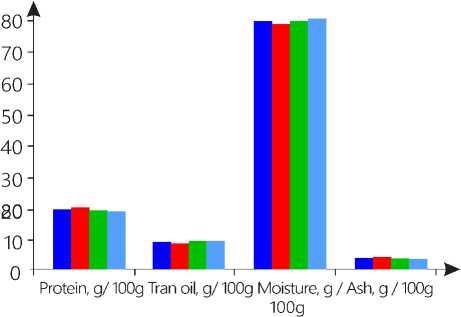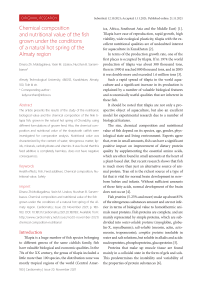Chemical composition and nutritional value of the fish grown under the conditions of a natural hot spring of the Almaty region
Автор: Dinara Zh. Moldagalieva, Yasin M. Uzakov, Nurzhan B. Sarsembaeva
Журнал: Cardiometry @cardiometry
Рубрика: Original research
Статья в выпуске: 20, 2021 года.
Бесплатный доступ
The article presents the results of the study of the nutritional, biological value and the chemical composition of the Nile tilapia fish, grown in the natural hot spring of Chondzhy, using different formulations of grower feed. Also, the chemical composition and nutritional value of the sharptooth catfish were investigated for comparative analysis. Nutritional value was characterized by the content of water, nitrogenous matter, lipids, minerals, carbohydrates and vitamins. It was found that this feed additive is completely harmless, does not have negative consequences.
Health effects, Fish, Feed additives, Chemical composition, Nutritional value, Safety
Короткий адрес: https://sciup.org/148322448
IDR: 148322448 | DOI: 10.18137/cardiometry.2021.20.180183
Текст научной статьи Chemical composition and nutritional value of the fish grown under the conditions of a natural hot spring of the Almaty region
Dinara Zh.Moldagalieva, Yasin M. Uzakov, Nurzhan B. Sarsem-baeva. Chemical composition and nutritional value of the fish grown under the conditions of a natural hot spring of the Almaty region. Cardiometry; Issue 20; November 2021; p. 180183; DOI: 10.18137/cardiometry.2021.20.180183; Available from: chemical-composition-nutritional
Tilapia is a huge number of fish species belonging to different genera of the same cichlids family, fish have valuable biological and economic qualities. In the 70s of the XX century, the genus of tilapia included a little more than 100 species, the distribution zone was mostly tropical regions of the world (Central Amer- 180 | Cardiometry | Issue 20. November 2021
ica, Africa, Southeast Asia and the Middle East) [1]. Tilapia have ease of reproduction, rapid growth, high viability, wide ecological plasticity, tilapia with the excellent nutritional qualities are of undoubted interest for aquaculture in Kazakhstan [2].
In terms of the production growth rate, one of the first places is occupied by tilapia. If in 1974 the world production of tilapia was about 300 thousand tons, then in 1990 it reached 800 thousand tons, and in 2005 it was double more and exceeded 1.6 million tons [3].
Such a rapid spread of tilapia in the world aquaculture and a significant increase in its production is explained by a number of valuable biological features and economically useful qualities that are inherent in these fish.
It should be noted that tilapia are not only a prospective object of aquaculture, but also an excellent model for experimental research due to a number of biological features.
The size, chemical composition and nutritional value of fish depend on its species, age, gender, physiological state and living environment. Experts agree that, even in small amounts, fish can have a significant positive impact on improvement of dietary protein quality by supplementing the essential amino acids, which are often found in small amounts at the heart of a plant-based diet. But recent research shows that fish is much more than just an alternative source of animal protein. Tran oil is the richest source of a type of fat that is vital for normal brain development in newborn babies and infants. Without sufficient amounts of these fatty acids, normal development of the brain does not occur [4].
Fish proteins (5-25% and more) make up about 85% of the nitrogenous substances amount and are not inferior in terms of biological value to homoithermic animals meat proteins. Fish proteins are complete, and are mainly represented by simple proteins, which are subdivided into water-soluble proteins (myoglobin, globu-lin-X, myoalbumin); salt-soluble (meosin, actin, acto-meosin, tropomeosin); complex proteins insoluble in water and salt solutions, but soluble in alkalis and acids: nucleoproteins, phosphoproteins, glucoproteins [5].
Proteins that make up muscle tissue are found mainly in a colloidal state in the form of gels and sols. This predetermines the instability and variability of the properties of protein substances [6].
According to AboutOrganics , only fish grown in special farms can be labeled as «organic».
The goal of research is to study the nutritional and biological value, the chemical composition of the Nile tilapia fish, grown in the natural hot spring of Chondzhy, using different formulations of grower feed. Also, the chemical composition and nutritional value of the sharptooth catfish were investigated for comparative analysis.
Materials and methods
Experimental studies were carried out in the conditions of a natural hot spring in the Almaty region. 4 groups of Tilapia and 4 groups of sharptooth catfish were formed for this aim in different age groups, which were kept in specialized rectangular pools without attachment. The optimal water temperature for Tilapia was 20-26 ° С, for catfish it was 15-18 ° С, the optimal concentration of oxygen dissolved in water for Tilapia was 20-21 ° С, the optimal concentration of oxygen dissolved in water for catfish was 9-12 mg/l. (МАРК-302Э - dissolved oxygen analyzer).
Sampling and organoleptic studies were carried out in accordance with the temporary methodology guidelines “Veterinary and sanitary examination of products of animal origin”, ST RK 1802-2008 Fish, seafood and products of their processing. Rules for acceptance and sampling, GOST 7631-85 “Fish, marine mammals, marine invertebrates and products of their processing. Acceptance rules, organoleptic quality assessment methods, laboratory test sampling methods “, ST RK 1803-2008 Fish and seafood. Sensory assessment methods. The fish were gutted, packed in ice and taken to the laboratory on the day of slaughter, all analyzes were performed the next day.
The chemical composition of fish flesh was determined by a set of methods: moisture - by drying at 1050C, tran oil - according to Soxhlet, total protein - by the modified Kjeldahl method, minerals - by burning in a muffle furnace (AOAC, 1980). Ash was determined using a muffle furnace with heating at 550° C for 8 hours. The calorie content of flesh was determined according to the Aleksandrov formula.
All data were subjected to one-way analysis of variance (ANOVA) using the Statistica 8.0 software to test the effects of experimental diets. All results are expressed as mean values ± SD.
Research results
The chemical composition of fish flesh, which determines its nutritional value and tastiness, is characterized, first of all, by the content of water, nitrogenous matter, lipids, minerals, carbohydrates and vitamins. The chemical composition of fish is not constant. It depends significantly on the species, physiological state, age, gender, habitats and other factors.
Table 1 provides the results of proteins, fats and ash concentration in the muscle tissue of Tilapia. In our experiments, with a comparative assessment of the flesh quality, it was found that the protein content in the flesh of tilapia from the group 3 was higher comparing with the other groups. The amount of protein in flesh was 15.71 ± 0.32 g / 100g in the first group, 16.86 ± 0.28 g / 100g in the second experimental group, – 17.72 ± 0.37 g / 100g in the third, 16.07 ± 0.55 g / 100 g in the fourth experimental group, respectively.
The results of the studies carried out indicate a high protein content in the flesh of the fish fed with feed based on the compound grower feed, which allows us to conclude about the high nutritional value
Table 1
Chemical composition and nutritional value of tilapia flesh from experimental groups when using the grower feed formulation
|
Indicators, Measurement units |
Experimental groups of tilapia (n = 20) |
|||
|
1 |
2 |
3 |
4 |
|
|
tilapia (grown in ponds) |
tilapia (juveniles and spawners) |
tilapia (optimal starting) |
tilapia (grown in pools) |
|
|
Protein, g / 100g |
15,71±0,32 |
16,86±0,28 |
17,72±0,37 |
16,07±0,55 |
|
Tran oil, g / 100g |
5,44±0,14 |
5,91±0,13 |
6,42±0,21 |
5,35±0,12 |
|
Moisture, g / 100g |
74,97±1,23 |
73,45±1,65 |
73,08±1,37 |
73,99±1,14 |
|
Ash, g / 100g |
1,04±0,87 |
1,28±0,52 |
1,45±0,41 |
1,14±0,24 |
|
Energy value kcal / 100g |
115,60±3,67 |
114,45±3,62 |
115,28±4,25 |
113,35±4,14 |
and these feed recipes application perspectiveness in the production of high-quality fish products.
The moisture content in the experimental group of fish was normal. A slight increase in the moisture content was observed in the flesh of the first experimental group, which increased by 2.02% in comparison with the second group, the third experimental group - by 2.52%, and the fourth - 1.3%. The conducted studies on the moisture content indicate that the grower feed formulation does not have a negative effect on the moisture content of the meat (Figure 1).

Protein, g/ 100g Tran oil, g/ 100g Moisture, g / Ash, g / 100g 100g '
■ 1 group ■ 3 group
■ 2 group ■ 4 group
-
Figure 1. The chemical composition and nutritional value of tilapia flesh in the experimental groups when using the compound grower feed formulation (g / 100g)
The tran oil content was 5.44 ± 0.14 g / 100g in the fish flesh of the first group, 5.91 ± 0.13 g / 100g in the second, 6.42 ± 0.21 g / 100g in the third, 5.35 ± 0.12 g / 100g in the fourth.
The ash content in all groups is practically at the same level (from 1.04 g / 100g to 1.45 g / 100g). The current values obtained from the study are almost the same with the results of the study of various salmon species published in Testi’s reports [7].
The energetic value of the tilapia flesh when using the compound grower feed formulation increased in the experimental groups of tilapia of group 1 (grown in ponds) and 3 (optimal starting), apparently, this is due to the fact that at such recipe concentrations, this compound grower feed is better taken up by fish.
Table 2 shows the chemical composition and nutritional value of the flesh in the experimental groups of sharptooth catfish when using a new compound feed formula in the diet. According to the research results, it was found that the protein content significantly increased in the experimental group 2, where the sharptooth catfish weighing from 3 to 25 grams were studied, compared to the experimental group 4. For example, the amount of protein was 16.71 g / 100g in the flesh samples of the 4th experimental group (weight from 100 to 500 grams), then it significantly increased in the first and second experimental groups to 4.62% and 7.57%, respectively. And the amount of protein in the third group was 17.09 g / 100g. Thus, there was an increase in the amount of tran oil in the third experimental group in comparison with the rest of the groups. The amount of tran oil was 7.28 g / 100g in group 3, while it noticeably decreases to 0.42 and 0.80 g / 100g in the first and second groups. And, the amount of tran oil in the 4th experimental group of catfish is 7.19 g / 100g (Figure 2).
Table 2
Chemical composition and nutritional value of the sharptooth catfish flesh in the experimental groups when using the compound grower feed formulation
|
Indicators Measure units |
Experimental groups (n = 50) |
|||
|
1 |
2 |
3 |
4 |
|
|
Sharptooth catfish juveniles weighing from 25 to 50 grams |
Sharptooth catfish underyearlings weighing from 3 to 25 grams |
Sharptooth catfish weighing from 50 to 100 grams |
Sharptooth catfish weighing from 100 to 500 grams and above |
|
|
Protein, g / 100g |
17,55±0,22 |
18,08±0,47 |
17,09±0,43 |
16,71±0,12 |
|
Tran oil, g / 100g |
6,86±0,33 |
6,48±0,51 |
7,28±0,12 |
7,19±0,08 |
|
Moisture, g / 100g |
77,72±1,55 |
77,02±1,24 |
77,89±1,37 |
78,67±1,41 |
|
Ash, g / 100g |
1,61±0,24 |
1,65±0,43 |
1,56±0,47 |
1,47±0,79 |
|
Energy value kcal / 100g |
90,45±3,54 |
90,97±3,22 |
88,35±3,19 |
89,60±2,90 |

■ 1 group ■ 3 group
■ 2 group ■ 4 group
-
Figure 2. Chemical composition and nutritional value of the sharptooth catfish flesh in the experimental groups when using the compound grower feed formulation (g / 100g)
The moisture and ash content in the experimental groups remained practically unchanged. If the moisture content reached 77.72 g / 100g in the first group, then it was 77.02 g / 100g in the second, 77.89 g / 100g in the third, 78.67 g / 100g in the fourth, respectively. The ash content also remained unchanged, all indicators were normal. Its amount was 1.67 g / 100g in the first group, 1.65 g / 100g in the second experimental group, 1.56 g / 100g in the third, 1.47 g / 100g in the fourth.
The results of the sterlet sturgeon flesh study show that the use of the Zeofish feed additive in the fish diet does not negatively affect the chemical composition of the flesh. The assimilation of the feed additive by sterlet sturgeon also remained within the normal range, as in the experimental groups of rainbow trout.
The results of the energy value analysis showed an increase in this indicator in the fish of the first, third and fourth experimental groups. The implication is that the more Zeofish feed additive in the diet, the better the condition of the fish organism, the energy value increases in proportion to the content of Zeofish feed additive in feed.
Thus, as a result of the chemical composition and nutritional value study of valuable fish species flesh (rainbow trout and sterlet) in the food consumption if which an unconventional feed additive Zeofish was supplemented, it was found that this feed additive is completely harmless, does not have negative consequences on the chemical composition of the experimental groups fish flesh, while there was a noticeable increase in some indicators in the experimental groups: protein in the first experimental group by 0.81%, in the second experimental group by 1.25%, in the third by
-
1.93%, in the fourth experimental group by 3, 16%, tran oil by 0.37%, 0.18%, 0.55, 0.74%, respectively.
Statement on ethical issues
Research involving people and/or animals is in full compliance with current national and international ethical standards.
Conflict of interest
None declared.
Author contributions
The authors read the ICMJE criteria for authorship and approved the final manuscript.
Список литературы Chemical composition and nutritional value of the fish grown under the conditions of a natural hot spring of the Almaty region
- Kiyashko VV, Gurkina OA, Klimenko AA, Golubeva NYu. Tilapia as an object of industrial aquaculture. Proceedings of the All-Russian Scientific and Practical Conference «Modern problems of live stock breeding in the context of innovative development of the industry». 2017. p.84-87. [in Russian]
- Shalgimbaeva SM, Asylbekova SZh, Sadvakasova AK, Sarmoldaeva GR, Kenzheeva AN, Dzhumakhanova GB. Study of the grower feeds effect on the microbiocenosis of tilapia organs in recirculating aquaculture systems. Bulletin of the Astrakhan State Technical University. Series: Fish industry. 2016. 56-65 pp.
- Privezentsev YA, Boronetskaya OI, Plieva TKh. Instructional guidelines for the replacement and breeding of tilapia of the genus Oreochromis. Moscow: Ministry of Agriculture of the Russian Federation, 2006. [in Russian]
- FAO, Food and agriculture organization of the United States. Fish is food for the brain as well as good protein. FAO USA, 2000. http://www.fao.org/focus/e/fisheries/nutr.htm.
- Arannilewa ST, Salawu SO, Sorungbe AA, Ola-Salawu BB. Effect of frozen period on the chemical, microbiological and sensory quality of frozen tilapia fish (Sarotherodun galiaenus). African Journal of Biotechnology. 2005; 4:852-5.
- FAO, Fisheries and Aquaculture Department, Proteins from fish and fish products. FAO, 2014. http://www.fao.org/fishery/topic/14869/en.
- Silvia Testi, Alessio Bonaldo, Pier Paolo Gatta, Anna Badiani. Nutritional traits of dorsal and ventral fillets from three farmed fish species. Food Chemistry. 2006; 98: 104–11.


